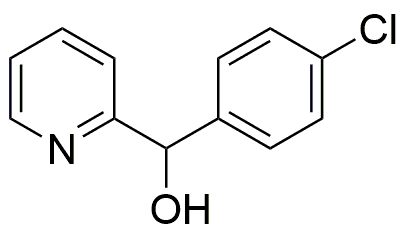a-(4-Chlorophenyl)-2-pyridinemethanol is widely utilized in research focused on:
- Pharmaceutical Development: This compound serves as a key intermediate in the synthesis of various pharmaceuticals, particularly those targeting neurological disorders, enhancing drug efficacy and specificity.
- Agricultural Chemistry: It is used in the formulation of agrochemicals, helping to develop more effective pesticides and herbicides that can improve crop yield while minimizing environmental impact.
- Material Science: The compound is incorporated into the development of novel materials, such as polymers and coatings, which exhibit enhanced durability and resistance to environmental factors.
- Biochemical Research: It plays a role in studying enzyme interactions and metabolic pathways, providing insights that can lead to breakthroughs in understanding disease mechanisms.
- Analytical Chemistry: This chemical is utilized in various analytical techniques, including chromatography and spectroscopy, aiding in the detection and quantification of other compounds in complex mixtures.
Información general
Propiedades
Seguridad y normativas
Aplicaciones
a-(4-Chlorophenyl)-2-pyridinemethanol is widely utilized in research focused on:
- Pharmaceutical Development: This compound serves as a key intermediate in the synthesis of various pharmaceuticals, particularly those targeting neurological disorders, enhancing drug efficacy and specificity.
- Agricultural Chemistry: It is used in the formulation of agrochemicals, helping to develop more effective pesticides and herbicides that can improve crop yield while minimizing environmental impact.
- Material Science: The compound is incorporated into the development of novel materials, such as polymers and coatings, which exhibit enhanced durability and resistance to environmental factors.
- Biochemical Research: It plays a role in studying enzyme interactions and metabolic pathways, providing insights that can lead to breakthroughs in understanding disease mechanisms.
- Analytical Chemistry: This chemical is utilized in various analytical techniques, including chromatography and spectroscopy, aiding in the detection and quantification of other compounds in complex mixtures.
Documentos
Hojas de datos de seguridad (HDS)
La SDS proporciona información de seguridad completa sobre la manipulación, el almacenamiento y la eliminación del producto.
Especificación del producto (PS)
La PS proporciona un desglose completo de las propiedades del producto, incluida la composición química, el estado físico, la pureza y los requisitos de almacenamiento. También detalla los rangos de calidad aceptables y las aplicaciones previstas del producto.
Certificados de análisis (COA)
Busque certificados de análisis (COA) ingresando el número de lote del producto. Los números de lote y de partida se pueden encontrar en la etiqueta de un producto después de las palabras "Lote" o "Lote".
Número de catálogo
Número de lote/lote
Certificados de origen (COO)
Este certificado de origen confirma el país en el que se fabricó el producto y también detalla los materiales y componentes utilizados en él y si se deriva de fuentes naturales, sintéticas u otras fuentes específicas. Este certificado puede ser necesario para cumplir con las normativas aduaneras, comerciales y regulatorias.
Número de catálogo
Número de lote/lote
Hojas de datos de seguridad (HDS)
La SDS proporciona información de seguridad completa sobre la manipulación, el almacenamiento y la eliminación del producto.
DownloadEspecificación del producto (PS)
La PS proporciona un desglose completo de las propiedades del producto, incluida la composición química, el estado físico, la pureza y los requisitos de almacenamiento. También detalla los rangos de calidad aceptables y las aplicaciones previstas del producto.
DownloadCertificados de análisis (COA)
Busque certificados de análisis (COA) ingresando el número de lote del producto. Los números de lote y de partida se pueden encontrar en la etiqueta de un producto después de las palabras "Lote" o "Lote".
Número de catálogo
Número de lote/lote
Certificados de origen (COO)
Este certificado de origen confirma el país en el que se fabricó el producto y también detalla los materiales y componentes utilizados en él y si se deriva de fuentes naturales, sintéticas u otras fuentes específicas. Este certificado puede ser necesario para cumplir con las normativas aduaneras, comerciales y regulatorias.


